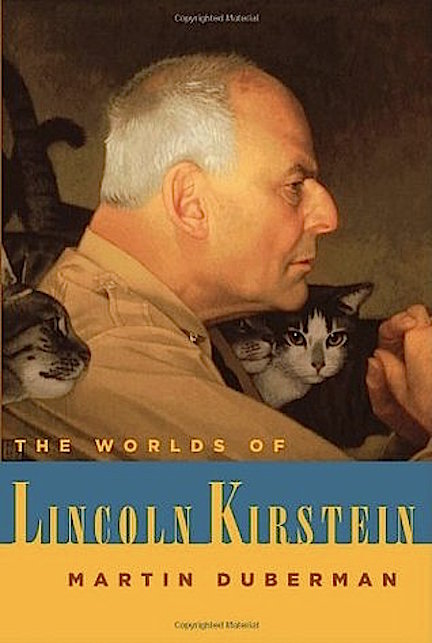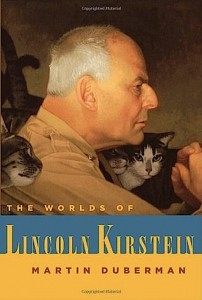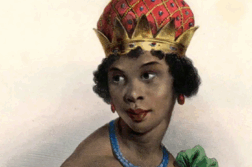In Part I of this essay, published in the January-February 2017 issue of this magazine, I described the recent discovery of a large amount of new archival material on Lincoln Kirstein, America’s “cultural czar” for much of the 20th century. The material is now housed in two manuscript depositories, the Houghton Library at Harvard and the Ransom Center at the University of Texas. Both collections, which consist primarily of previously unknown correspondence, are open to researchers. While the new material doesn’t fundamentally change the portrait I offered in my 2007 biography, The Worlds of Lincoln Kirstein, it does deepen and enrich our understanding of the multiple worlds that this extraordinary man inhabited and the remarkable circle of people with whom he came into contact.
Part I focused primarily on how the new material augments our understanding of Kirstein’s relationship with George Balanchine and their cofounding of the New York City Ballet Company in 1933. In Part II, I widen the lens to discuss Kirstein’s circle of prominent gay artists.
WE BEGIN our story with Lincoln’s sister Mina, ten years his senior. In the early 1920s, when Lincoln was a teenager, Mina was on leave from her teaching post at Smith College and sharing a small 18th-century house in London with an ex-student, Henrietta Bingham, daughter of Robert Worth Bingham, owner of the Louisville Courier-Journal and future ambassador to the Court of St. James. Henrietta had been in one of Mina’s first classes at Smith, and the two women, only a few years apart in age, had fallen in love and decided to travel together in Europe.*
Mina didn’t think of herself as “lesbian,” though she was unapologetic about their relationship, describing it as “an extremely beautiful and honest one.” Yet—unlike Henrietta’s—Mina’s primary relationships for most of her life were with men. That said, her affair with the tall, strikingly attractive and charismatic Henrietta was more than a brief fling: for years after their relationship ended their lives remained centrally entwined, and the protective Mina would for decades faithfully answer the call to extricate the fragile, unstable Henrietta from assorted plights. One day in 1922, when still living with Henrietta in London, Mina stopped off to browse in a bookshop near the British Museum. The owner, a tall, blond, blue-eyed 29-year-old named David Garnett started to chat her up—yes, that David Garnett, a prominent member of the sexually unorthodox Bloomsbury set, which also included Virginia Woolf, Vanessa Bell, the iconoclastic homosexual historian Lytton Strachey, and a host of other now legendary people. Before long, Garnett invited Mina—and Henrietta—to tea, and in the weeks that followed, all three became friends. The two young, attractive women were soon introduced to assorted other members of the Bloomsbury circle, including Strachey, Dora Carrington—who was immediately smitten with Henrietta—and Dora’s somewhat reserved (for Bloomsbury) husband Ralph Partridge. Garnett later claimed that he’d fallen for Mina that very first day in the bookstore. Yet their relationship never became sexual, due entirely to Mina’s misgivings (she blamed her own “strong if often inactive sense of Puritan morality”); Mina and Garnett would remain deeply companionable friends for decades. Garnett was never at a loss for sexual partners (including, subsequently, Henrietta Bingham—to Mina’s annoyance). In 1922 he was already a husband and a father (a novelist, too), and throughout his adult life he took male as well as female lovers. Before his marriage, he’d been lovers with the painter Duncan Grant, and the two had shared a house with Virginia Woolf’s sister, Vanessa Bell, who gave birth to Grant’s child Angelica. Bloomsbury was, as we now say, “sexually fluid.” (Years later, in a triple somersault, Garnett would marry Angelica). Mina and Lincoln (at this point still a teenage schoolboy) shared at least some of their sexual adventures with each other. In one of the recently acquired letters now at Houghton Library, Lincoln reported that his father had gotten a massage from “the most handsome blonde Swede I ever saw. I would have loved to but feared the results.” He also reported that he and his close friend Howard Dougherty (later the distinguished biographer of Francis Parkman) were having sex, and that Howard had expressed astonishment at how easily Lincoln got an erection. “How one’s ex-boyfriends do pile up,” the fifteen-year-old nonchalantly added. In 1924 Lincoln again spent his summer in Europe, and Mina introduced him to some of the Bloomsbury crowd. The contacts, though, were mostly casual—he barely glimpsed E. M. Forster at some gathering (though a decade later the two would become friends). The only Bloomsburyite Lincoln got to know reasonably well that summer was the economist John Maynard Keynes who, despite his many sexual encounters with men, would soon marry the Diaghilev ballerina Lydia Lopokova. Keynes took Lincoln to Gauguin and Cézanne exhibitions; when Lincoln expressed reservations about Cézanne, Keynes urged him to “keep your eyes open, clean of received opinion and prejudice.” It was advice that Lincoln took to heart. He would later write that Keynes had “launched a radical reformation in my naïve judgment.” Two years later, Lincoln became a freshman at Harvard, where he proceeded to ignore most of his classes and to spend his time instead on founding, remarkably, both an avant-garde art gallery (the precursor and model for the Museum of Modern Art) and a pioneering literary journal, Hound and Horn. Even as a young man, Lincoln’s finely tuned antennae were quick to filter out artistic mediocrity and to encourage promising new voices. However, like nearly everyone else, he now and then proved surprisingly tone deaf. While a modernist in sensibility, Kirstein was and would remain a moderate modernist. He published Ezra Pound in Hound and Horn, but not James Joyce. In the realm of painting, he would always favor representational art over cubism and abstract expressionism, sometimes promoting the work of lesser figures—William Rimmer, Alex Colville, Honoré Sharrer—while dismissing someone like Fernand Léger as “stiff as static machinery, the stenciled formula of a genial mechanic.” Years later, in the 1950s, when abstract expressionism ruled the art world and Kirstein’s close friend, the painter Pavel (“Pavlik”) Tchelitchev, accused him of a blanket distaste for it, Lincoln fired back a firm denial (the newly recovered letter is in the Ransom Center): “I do not hate abstract art, as you insist; I recognize the abstract purity of Mondrian, and of certain classic Cubist Picassos. … But Pollack and [Theodoros] Stamos and [William] Baziotes and all the rest of them who think they are abstract are actually only accidental. … They think by twirling the handle they can unlock the safe; they think the sounds of any struck chord have their own significance; and it may be true there is an order in accident, but it is an inferior order.” IN THE 1930s, Lincoln began to make occasional trips to New York City where, before long, he met the then-famous free spirit Muriel Draper, twenty years his senior, whose coach house on East 40th Street was a mecca for the city’s “high bohemia.” In one of the letters to Mina recently made available, Kirstein, barely out of his teens, described his initial impression of Draper, opting for a blasé, debonair pose: “She had [with her]one of the nastiest little homosexual boys I ever saw. … I acted pretty well the innocent Harvard freshman all health and tanned. … The talk was clever and depressing and crazy—honey, she is so cuckoo. … She was dressed all in white—with a mauve lipstick. … I could quite see she has a good heart and beneath the galvanization of her nerves … she is quite sweet, kind and fine.” During subsequent trips to New York, Kirstein got to know Muriel better—much better—and to appreciate her a great deal more. Before long they began what would be a decade-long intermittently sexual affair which, by the time Kirstein had moved to New York in 1930, greatly intensified. By then Kirstein had come to appreciate—to marvel at—just how special Muriel actually was: she “has all her barriers down all the time” and is “quite without conventional restraints.” Throughout the ’30s, Kirstein would see more of Muriel than anyone else; he called her his “dominant companion and influence,” and through her gained entrance to much of New York’s smart set. Later, their relationship would become attenuated, as Muriel became increasingly absorbed in pro-Soviet activities and as Kirstein’s devotion to the dance and art worlds broadened. Like so many others on the Left—though not Muriel—Kirstein’s left-wing views of the 1930s later morphed into a kind of vague liberalism. Still, he and Muriel never lost track of each other entirely. In 1947, on one of her many trips back and forth to Moscow, she seemed to him “old and tired”; he thought it possible that “she will one day drop dead of exhaustion, but I guess that is the way she wants it.” Still, in 1949, again on her way back from Moscow, Kirstein found her “as enthusiastic as ever … still marvelous, like the best of the old days. She goes to China and Mexico; how she manages, I’ll never know; except that no one seems to care.” By that time the Cold War had set in, and the House Un-American Activities Committee proved that it cared, denouncing Muriel for “Communist-front” activities. When she died of a paralytic stroke in 1952, Kirstein wrote that “part of my life [is]gone. … She stays with me much of the time; she educated me and focused me and I am forever grateful.” During most of the 1930s Lincoln shared Muriel’s activist views, and when in London in 1933 he became so agitated about the rise of the Nazis that he attended a Fascist meeting, the better to gauge their sentiments and influence. He came away railing at what he called (in one of the new Houghton letters) “the Fascist face—mean, self-assured … and intensely mediocre: it is something to spit at.” He deplored the fact that Viscount Rothermere, proprietor of the popular Daily Mail, was engaged in a “frenzy of rapprochement with Hitler.” (In 1939, Rothermere sent congratulations to Hitler on the annexation of Czechoslovakia and his “great and superhuman” work). There were too many Rothermeres in England for Kirstein’s taste—or peace of mind (he was Jewish)—though he counted on the country’s essential soundness. On that same trip to England, Lincoln looked up Henrietta Bingham, currently busy at the American Embassy, where her father had recently become Ambassador to England. “Her charm,” Lincoln reported to Mina, “now fits all around like a glove—but what is inside I’d rather not think of.” He further reported that Henrietta’s new girlfriend was the actress Hope Williams (she’d starred opposite Jimmy Durante in the 1930 Cole Porter revue The New Yorkers), though he’d been told that Tallulah Bankhead was courting Henrietta as well. Lincoln also spent time with Mina’s old friend (and would-be lover) David Garnett, who took him to several gatherings of the Bloomsbury clan, including a party at Roger Fry’s, the esteemed art critic. The sibling Sitwells, Osbert and Edith, were there, as was Virginia Woolf (whom Kirstein initially managed to mistake for Vanessa Bell), looking—so he wrote to Mina—”very gaunt in a lace cap, and frightening.” At another Bloomsbury gathering, a picnic with Duncan Grant and the Woolfs, Virginia’s husband Leonard told Kirstein (as another newly available letter recounts) that “he is completely mystified as to F.D.R.’s policy; he feels he has no interest whatever in Europe—which is what everyone here thinks.” It was also on this same trip that Lincoln met the non-Bloomsburyites Stephen Spender and E. M. Forster, the former through Hound and Horn connections, the latter through William Plomer, a young novelist whose 1926 Turbott Wolfe, a denunciation of South Africa’s brutal racial policies, had caused a sensation. Spender brought along Tony Hyndman, his lover at the time, and Kirstein (as he wrote in his diary) fell “acutely in love” with their relationship, with “their life together.” He took immediately to Hyndman (“simple, frank, yet cunning … and entirely male”), somewhat less to Spender. He thought the latter “slightly wet behind the ears” with a “spiteful” side—as when he characterized his friend Isherwood as “a small man whose jealousy and intrigues rise from his height.” When Kirstein later met Isherwood—who he referred to as “Issyvoo”—it was in Los Angeles, where Isherwood was working for Goldwyn and (according to one of Kirstein’s letters to Mina) was “wildly unhappy,” drinking too much, and worrying aloud about whether he should return to England (where he and Auden had been denounced for abandoning the Motherland in her time of need). Kirstein accurately predicted that Isherwood would not return. In the postwar period, Kirstein and his wife Fidelma (see Part I for a discussion of their marriage) often saw Isherwood and his current lover, the photographer Bill Caskey. In 1947 the couple visited the Kirsteins in their beloved summer hideaway on Fire Island. Caskey had a reputation in some quarters as an aggressive, disruptive “truth-teller,” but Kirstein liked him enormously, describing him as a “no nonsense … tough little customer … cold as ice underneath.” Isherwood had already published two of his most famous works, Prater Violet and The Berlin Stories, and during the Fire Island visit he shared parts of his private diary with Kirstein, who found it (as he wrote Mina) “a very remarkable precise English commentary, in a rather rigid evangelical tone of the intimate horrors of our time; realistic, very detailed, astonishingly honest and cold. … Like a more intelligent Pepys or Evelyn, but combined with amazing portraits and narratives.” (Expertly edited by Katherine Bucknell, three volumes of Isherwood’s diaries have now been published [in 2000, 2010, and 2012]and bear out Lincoln’s estimate). YEARS LATER, in the mid-1960s, Don Bachardy—who had long since displaced Caskey as Isherwood’s life partner—paid a visit to New York to promote his drawings and portraits, and he stayed with Kirstein and Fidelma in their house on 19th Street. The visit was not a success. Bachardy reported to Isherwood that “Lincoln is still manic and oh! so difficult”—an understandable reaction given Kirstein’s sometimes severe mood swings during these years. Less understandable was Bachardy finding him “boring to be with”—an estimation that no one else ever shared. When Kirstein gave Bachardy the handsome commission of $2,000 to do some drawings of the New York City Ballet Company, Bachardy himself called the payment “extravagant,” unattractively adding in a letter to Isherwood that “if Lincoln is going to throw his money around, I see No reason why Kitty [Bachardy’s pet name] should be criticized for taking off his little hat (very respectfully) and catching a coin or two.” Bachardy also mocked Kirstein’s critical tastes, writing that he “doesn’t have the faintest idea of what’s any good, and if he did, wouldn’t have the courage of his conviction”—an estimate that can only be called astonishing, given Kirstein’s fearless public opposition to abstract expressionism when it was at its height of popularity. He was no less fearless in defending various representational artists (including Andrew and Jamie Wyeth) whom the smart set disparaged. Bachardy concluded, rather hair-raisingly, that Lincoln “is the most awful coward, and will back down at the slightest bark from any ass, including Madam Balanchine, who may be a genius as a choreographer but is just a vain, silly know-nothing about other things, most particularly ‘the visual arts’”—descriptions of both men of breathtaking obtuseness. Not surprisingly, soon after Bachardy’s visit, Kirstein’s friendship with Isherwood became distant to the point of disappearance. Far from fading into the woodwork rather than offend, Kirstein would sometimes speak his mind with such ferocity as to produce considerable offense and in some cases a rupture in relations. One case in point is his reaction to his brother-in-law (and close friend) Paul Cadmus’ 1945 painting Lust, the first in what became a famous series titled The Seven Deadly Sins. Pulling no punches, Kirstein told Cadmus that the painting was “horrible”: “it is so full of hate and disgust, in an active way, that it is quite paralyzing.” Kirstein went on to admonish Cadmus for his “aching agony about the flesh. I suppose it partly comes from hating being queer, and partly from [the]curdled catholicism of your nasty youth … maybe the nicest thing about all of us is our poor half-stiff peters and stretched, hungry cunts.” Cadmus was a gentle soul who avoided conflict, took Kirstein’s intemperance in stride (however hurt by it), and stayed close to him throughout their long lives. And Kirstein did his part to make that possible. As I wrote in The Worlds of Lincoln Kirstein: “Lincoln could be recklessly impatient with people, bluntly and hurtfully saying what he felt at the moment, but he was at bottom a bad hater; he would secretly do an important favor for someone he wasn’t speaking to, would loan money to an acquaintance whose talent he’d lost confidence in, or would ‘forget’ two weeks after a shouting match that it had ever taken place, casually embracing the person who’d recently been his fierce antagonist.” The writer Donald Ritchie put his finger on another essential ingredient in Kirstein’s personality: “You are a very moral person,” he wrote to Kirstein, “in this world of slipping and slithering and sliding standards there are some which remain inviolate … you stand for these and observe them.” An example of such standards is Kirstein’s reaction to Gertrude Stein’s behavior during World War II. One of the newly released letters in the Ransom Center collection from Kirstein to Pavlik Tchelitchev begins by praising “lots of young rich Parisiens who behaved magnificently [during the war], tricked the Germans time and again under the disguise of being silly and mondain.” He could not say the same, he went on, for Gertrude Stein “writing non-stop” under the protection of Professor Bernard Faÿ, a specialist in American literature and a close adviser to Marshal Pétain, head of the pro-Nazi Vichy government. Later, when Faÿ was tried as a collaborator, Stein wrote a letter in his defense. Kirstein was angered, too, at a number of other artists—he named Charles Despiau, André Segonzac, Roland Oudot, and André Derain—all of whom had accepted an invitation to Berlin in 1941 to attend an exhibit of the Nazi-endorsed painter Arne Brecker. They did so, in Lincoln’s view, “not by necessity but to curry favor.” Kirstein wrote from Europe to Tchelitchev: “I learn a lot about evil and I have developed a hate of people that frightens me.” He was pleased after the war when the ballet luminary Serge Lifar was tried and imprisoned for having seen to it that the lights of the Paris Opera be turned on—after all the workmen on the premises had refused to do so—in order to give Hitler a personal tour. Kirstein downplayed his own dramatic experiences during the war, the result of a lucky break (though he was only an army private) in being assigned to the now famous Arts and Monuments Commission. He and his commanding officer, Captain Robert Posey, through a series of accidental tips, found themselves hot on the trail of the famed polyptych, The Adoration of the Lamb—the so-called Ghent Altarpiece painted by the brothers Hubert and Jan van Eyck between 1426 and 1432, stolen by the Nazis and hidden, as the war turned against them, at some unknown location known to be a salt mine. Thanks to the Ransom Center’s newly acquired Kirstein–Tchelitchev correspondence, we now know more about the location of that salt mine in Austria’s Alt Aussee region, which had become by 1945 the central assembly point for looted treasures ultimately destined for Hitler’s “super-museum” at Linz. The Alt Aussee mine had ideal climate-controlled conditions for storing art, and the Nazis had converted it into a state-of-the-art storage facility. In March 1945, with the war going badly, Hitler had issued what became known as the Nero Decree ordering the destruction at supply sites of anything that might be of use to the Allies. Martin Bormann, Hitler’s secretary, sent a letter to August Eigruber, the Nazi officer in charge of the Alt Aussee region, that seemed to make it clear—or so Eigruber insisted—that works of art were to be understood as included under the Nero Decree. The advancing Allied armies regarded Alt Aussee as unimportant strategically and even somewhat dangerous, given the remnants of SS troops known to be hiding out in the mountainous terrain. But when Posey and Kirstein informed General Patton that a vast amount of stolen art was probably buried in the Alt Aussee mine, he redirected the Third Army to the site. Scattered SS troops still guarded the mine, which was known to be wired for detonation with 500-kilogram aircraft bombs. Were the bombs to go off, they would certainly have collapsed the mine and buried the art. August Eigruber, a devoted follower of Hitler, was determined to carry out the Führer’s Nero Decree and completely destroy the mine. He was foiled by a group of anti-Nazi Austrian officers, in cooperation with a number of brave local miners who’d been active in the Resistance. Working secretly at night, the miners somehow managed to elude the SS guards, remove the bombs from their crates, and set off enough explosives to seal the opening to the mine without damaging the art within. The Third Army arrived at Alt Aussee on May 8, one day after Germany surrendered unconditionally at Reims. The debris blocking the entrance to the mine was soon cleared away, and, with one of the miners as their guide, Posey and Kirstein, holding up acetylene lamps, were the first to enter. They opened two padlocks on an iron door, and there at their feet, unwrapped, lay the eight panels of The Adoration of the Lamb. Over the next few days, a cornucopia of other treasures emerged, including a Vermeer self-portrait and Michelangelo’s marble Madonna from Bruges. _____________________ * For more on Henrietta Bingham’s fascinating life, see her granddaughter Emily Bingham’s 2015 biography, Irrepressible: The Jazz Age Life of Henrietta Bingham (Farrar, Straus and Giroux). Martin Duberman is professor emeritus of history and the founder of clags. His latest book is Jews/Queers/Germans: A Novel.






